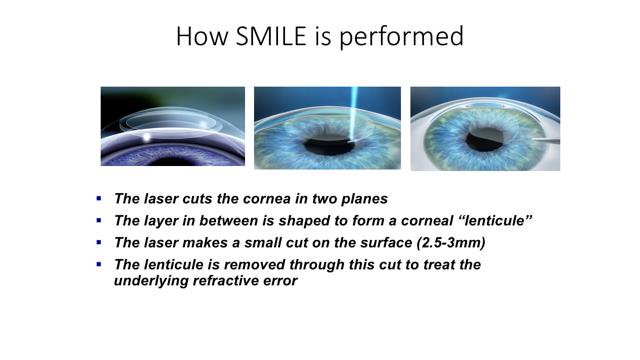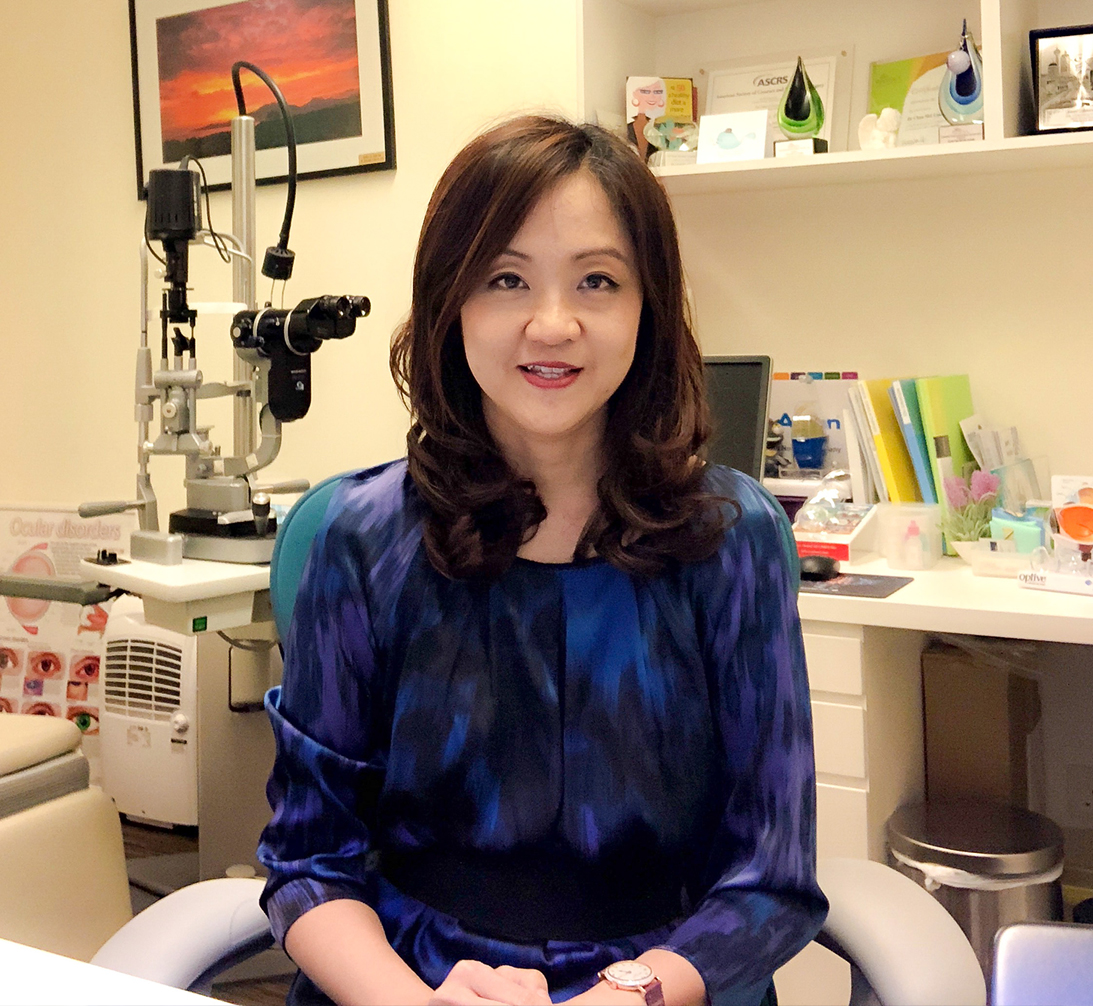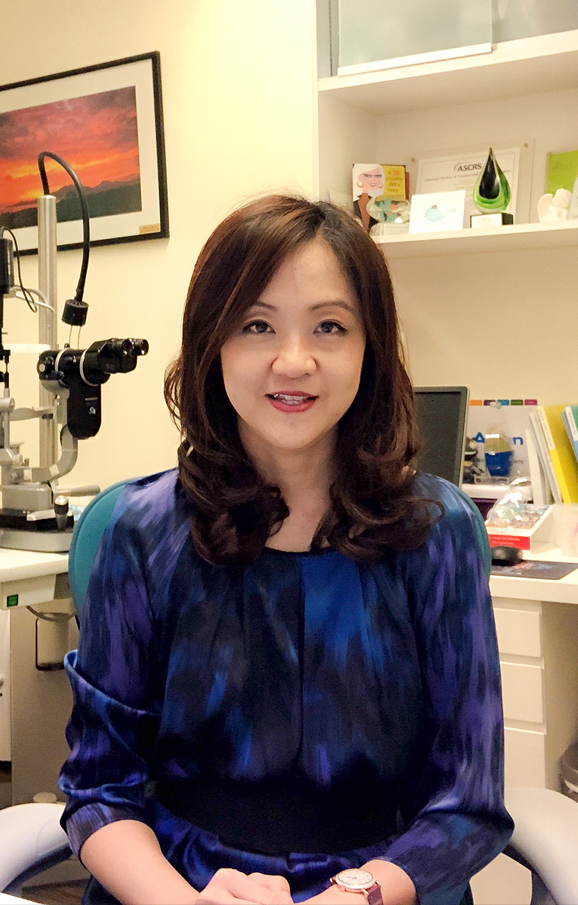ReLEx SMILE in Singapore
What is ReLEx SMILE?
ReLEx SMILE (more commonly known as just SMILE) is a fairly recently developed outpatient laser surgical procedure used to treat the following:
- Short-sightedness (myopia)
- Astigmatism
ReLEx SMILE surgery is one of three main types of laser vision correction procedures, designed to reduce your dependence on glasses or contact lenses. It is primarily used to treat nearsightedness, and can correct prescriptions of up to -10.00 diopters.

In SMILE, a small piece of tissue from within the cornea is removed to alter the shape of the cornea to improve the way light rays are focused on the retina. In most cases, spectacle and contact lens independence is achieved.

If you want clearer vision without the hassle of glasses or contacts, book a consultation today to see if SMILE laser vision correction is the right choice for you.
Benefits of ReLEx SMILE
Some benefits of ReLEx SMILE that make it a preferred choice for many patients:
- Superior Safety and Stability – Unlike traditional LASIK, SMILE doesn’t involve cutting a corneal flap. This reduces the risk of complications and also contributes to better long-term corneal stability.
- Minimally Invasive and Comfortable – SMILE only uses a 2 to 4 mm wide keyhole incision. It is less invasive and more comfortable than traditional laser surgeries.
- Quick Recovery and Long-Term Results – Many patients experience visual improvement within days with minimal downtime. The procedure also boasts a very low rate of regression, allowing patients to enjoy clear vision for many years.
- Ideal for Diverse Lifestyles – As a flapless procedure, SMILE is a great option for people with active lifestyles or those at risk of eye trauma. There is also no risk of flap-related complications if the eye is accidentally rubbed or hit after surgery.
- Broader Eligibility – SMILE is suitable for people who might not have been ideal candidates for other procedures. This can include patients with thinner corneas, dry eyes and higher degrees of myopia.
How is ReLEx SMILE performed?
Here is what to expect:
You will be awake during the surgery and no sedation is necessary.
- The procedure is generally a comfortable experience with minimal pain.
- The eye is first numbed with anaesthetic eye drops.
- The procedure involves the use of a single laser platform i.e the femtosecond laser.
- A small piece of tissue created by the laser called the corneal lenticule is removed through a small incision (wound) on the cornea. The result of removing this lenticule is to flatten the cornea in the case of short-sightedness or make it more rounded in the case of astigmatism. This changes the focusing power of the cornea and improves your vision.
- There is no corneal “flap” unlike in LASIK
- The corneal wound will self-seal without the need for stitches
- It generally takes 15-20 minutes to perform SMILE in both eyes
A video showing how SMILE eye surgery is performed. A femtosecond laser is used to create precise surgical planes within the cornea, along with a small incision on the surface. The surgeon then removes a small piece of tissue called the “lenticule” through this small incision to change the cornea's shape. For myopia, the cornea is made flatter to reduce its refractive power. For astigmatism, the cornea is reshaped to be more symmetrical, improving how light focuses on the retina.
Am I a Good candidate for ReLEx SMILE?
Generally, in order to undergo SMILE, you should:
- Be at least 21 years of age
- Not be pregnant or breastfeeding
- Be free of other eye diseases
- Have a stable refraction i.e the prescription for your glasses should not have changed much in the last year
- Fulfill certain criteria with regard to cornea thickness, cornea shape and refractive error (degree). Patients with thin or irregular corneas, severe dry eye, cataract, glaucoma, uncontrolled diabetes, rheumatoid arthritis and other collagen vascular diseases are unsuitable for SMILE.
Most importantly, you must have realistic expectations about the outcome of the procedure, and be willing to accept the potential risks associated with it. Fortunately, SMILE is very safe, and the results are excellent.
Evaluation for SMILE Surgery Eligibility
During the evaluation, the patient will undergo a comprehensive eye examination. These include tests like:
- Autorefraction – A machine-based test that quickly measures a person’s eyeglass prescription.
- Tonometry – A test that measures the intraocular pressure (IOP) or the eye pressure.
- Lenstar – A high-precision biometrical assessment of the eye.
- Orbscan – A corneal topography system that evaluates the corneal surface.
- Sirius – A 3D imaging device used for corneal and anterior eye analysis.
- Subjective Refraction – A manual test to find the best corrected visual acuity.
If you are suitable for SMILE surgery, our surgeon will provide preoperative instructions, including recommendations such as discontinuing contact lens use before consultation and surgery.
What to Expect after ReLEx SMILE
Here are important points to note:
- Visual recovery after SMILE is not instantaneous.
- You will find that your eyesight is still foggy immediately after SMILE. The vision usually improves gradually over the next few days. By the next day, you will be able to see well enough to perform most of your daily activities, but stabilization of vision may take a few weeks to 3 months, especially for higher prescriptions or astigmatism.
- When the effect of the anaesthetic eye drops wears off, some patients may experience pain, tearing, burning sensation, scratchiness and / or difficulty opening their eyes, the severity of which varies from patient to patient. These symptoms usually disappear after 6-8 hours. Most patients find the discomfort mild and bearable.
- Healing after SMILE is usually comfortable as the laser removes tissue from the inside of the cornea rather than from the more sensitive surface of the cornea.
- You will be prescribed antibiotic and steroid eye drops as well as artificial tears to keep the eyes moist.
- To ensure proper healing, avoid rubbing your eyes, swimming, smoky or dusty environments, wearing eye makeup, contact lenses, and strenuous activities for a few days.
- Stay hydrated and eat nutritious foods that support healing and recovery.
Overall, the surgery and post-surgery recovery, like LASIK, is a pleasant experience for most patients.
Most patients are able to return to work a day or two later.
Stabilization of vision varies. For some patients, it may take several weeks or a few months.
Side Effects, Risks, and Complications of ReLEx SMILE
Like any other surgery, SMILE has side effects that you need to know about and carefully consider before deciding on having the surgery. Fortunately, SMILE is a very safe procedure and most of the side effects are mild and temporary. These include dry eye, fluctuating vision, hazy vision, haloes and glare in a dim environment and light sensitivity. Over- and under-correction may also occur, and a “top up laser” procedure called “enhancement” may be required in some cases. Serious side effects that can result in loss of vision are extremely rare, and these include severe inflammation, infection and corneal ectasia (weakening and thinning of the cornea).
What Will My Vision be Like after ReLEx SMILE?
Imagine not having to fumble for your glasses to check the time when you open your eyes the first thing in the morning. Imagine not needing your glasses and contact lenses to read, drive, use the computer, swim or scuba dive. SMILE can give you this life-changing experience.
However, it is important for you to have realistic expectations when considering SMILE for yourself. Stabilization of vision takes a few weeks or a few months, and varies from patient to patient. SMILE allows most patients to perform most of their everyday tasks without glasses or contact lenses, but in some cases, these corrective aids may still be required.
SMILE cannot correct presbyopia, the age-related loss of near vision due to a loss of the auto-focusing power of the eye. With or without SMILE, most patients will require glasses for reading after the age of 45. Some people choose a vision correction method called monovision, which leaves one eye slightly short-sighted to allow for close work, while the other eye is adjusted for distance vision. Monovision works well for many patients, and your eye doctor will help you decide if you are suitable for this.
An Important Point to Note:
SMILE is technically more difficult to perform than LASIK eye surgery, and occasionally problems with the creation and removal of the corneal lenticule can occur during surgery. If this occurs, the doctor may choose not to complete the SMILE treatment. This is uncommon, but it is very important to choose an experienced SMILE surgeon to perform the procedure, as adequate handling of such problems during surgery comes with experience.
Is LASIK or SMILE Better for Me?
Both LASIK and SMILE are safe and excellent laser vision correction procedures. Each procedure has its inherent advantages. Visual recovery and stabilization from LASIK is generally faster, but SMILE, being a “flap-free” procedure, may be more suitable for patients involved in high-impact sports and other vocations.
Dr Cordelia Chan has had many years of experience performing both LASIK and SMILE in thousands of patients, and based on your profile and needs, she will be able to best advise you on which procedure is better.
Why Choose Our Surgeon for Your ReLEx SMILE Surgery?
Choosing the right surgeon matters, especially for advanced vision correction like ReLEx SMILE. Our surgeon is trusted by patients for her:
We encourage you to consult our ophthalmologist to discuss whether ReLEx SMILE is the right choice for your vision goals. Contact us today to schedule an appointment.
Frequently Asked Questions
What is the cost of ReLEx SMILE surgery in Singapore?
Can I use MediSave or insurance to pay for ReLEx SMILE surgery?
Is ReLEx SMILE permanent?
How soon can I drive after ReLEx SMILE eye surgery?
MBBS (S’pore), FRCS (Edinburgh), MMed (S’pore), FAMS (Ophth)


Dr Chan is an experienced ophthalmologist in Cornea and Refractive Surgery in Singapore. She was among the first in the country to perform ReLEx SMILE, as well as bladeless LASIK and lamellar corneal transplantation. Dr Chan is internationally recognised for her contributions to the field through leading organisations such as the American Society of Cataract and Refractive Surgery (ASCRS), European Society of Cataract and Refractive Surgeons (ESCRS), and the Asia-Pacific Academy of Cataract and Refractive Surgery (APACRS), among others. Her practice focuses on delivering safe, precise, and minimally invasive vision correction tailored to each patient’s needs.
